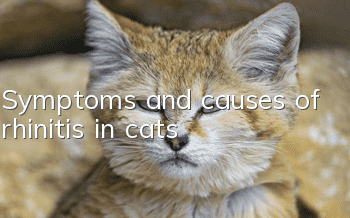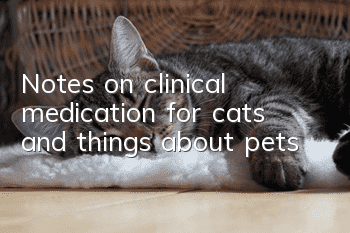Symptoms and causes of rhinitis in cats

Analysis of the causes of rhinitis in cats
Cats, like people, also suffer from rhinitis, and feline rhinitis can be divided into acute rhinitis and chronic rhinitis, and the symptoms of the two types of rhinitis are also different. Feline rhinitis will cause your cat to sneeze and have a runny nose, but this is not always the case. So what exactly causes rhinitis in cats?
1. Stimulated by the cold winter air, the cat’s nasal mucosa is prone to congestion and exudation, so the bacteria that are present in the nasal cavity take the opportunity to develop and multiply, causing mucosal inflammation.
2. When a cat inhales ammonia, chlorine, smoke, dust, pollen, insects, etc., it directly irritates the nasal mucosa and can also cause nose inflammation.
3. Cat rhinitis may also be secondary to the spread of certain infectious diseases or inflammation of adjacent organs.
Clinical symptoms of cat rhinitis
Feline rhinitis is a common respiratory disease in cats. Cats suffering from this disease will show sneezing and runny nose at the beginning of the disease, but this situation is not absolute. Since feline rhinitis can be divided into chronic rhinitis and acute rhinitis, the manifestations are also different.
1. Chronic rhinitis: The condition develops slowly, with nasal discharge that is more or less frequent and mostly mucopurulent. If inflammation spreads to the paranasal sinuses, it can often cause bone necrosis and tissue disintegration, so the nasal mucus may be mixed with blood and have a putrid smell. Chronic rhinitis can often be the cause of suffocation or encephalopathy and should be taken seriously.
2. Acute rhinitis: At the beginning of the disease, the nasal mucosa is flushed and swollen, and sneezing occurs frequently. The sick cat often shakes its head or scratches its nose with its front paws, and then nasal mucus flows from one or both nostrils, which is initially transparent and serous. , and then become serous mucinous or mucopurulent, and dry scabs form around the nostrils. When the condition is severe, the nasal mucosa swells significantly, narrowing the nasal cavity, affecting breathing, and nasal congestion can often be heard. When accompanied by conjunctivitis, the patient may shed tears due to embarrassment. When accompanied by pharyngitis, difficulty swallowing, coughing, and swollen mandibular lymph nodes occur.
- Do cats suffer from post-holiday syndrome? The main symptoms are anorexia, picky eating, depression, etc.
- How to prevent cats from scratching leather sofas?
- What is the reason why Ragdoll cats have gums in their eyes? A must-read for cat parents!
- What should I do if my cat’s eyes are inflamed? Is it suitable to use human eye drops?
- How to train your cat to be different? Cat Training!
- How to prevent cats from being infected with parasites? A senior poop shoveler vomits blood and sorts it out!
- Can a pregnant cat touch its belly?
- Why do Singaporean cats need to be neutered?
- What is the cause of gradual hair loss?
- Will cats be lonely at home?



